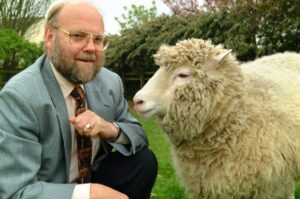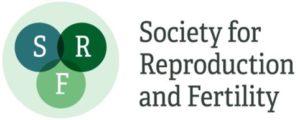Passing of Professor Sir Ian Wilmut, OBE, FRS, FMedSci, FRSE
It is with great sadness that the society announces the death of one of its former members, Professor Sir Ian Wilmut. Ian was joint recipient of 2008 Shaw Prize with Professors Keith Campbell and Shinya Yamanaka, and he delivered both the Hammond Lecture (1998) and Parkes Lecture (2002) to the society. Ian had in recent years been suffering from Parkinson’s disease and he passed away on Sunday 10th September 2023 at the age of 79. Ian of course is best remembered for leading the programme of research at the Roslin Institute during the 1990s that led to the birth of ‘Dolly the sheep’, the first animal to be cloned from an adult (somatic) cell. This has frequently been heralded as one of the great scientific achievements of the 20th century, the legacy of which continues to this day particularly in the field of stem cell research and regenerative medicine. However, Ian’s interests went further than that, and his legacy is punctuated by numerous significant achievements spanning the last half-century, as summarised below.
Ian was born near Stratford-upon-Avon in 1944 before moving with his family to Scarborough in Yorkshire. It was at school there that he developed his interest in biology, and weekend work on local farms in Yorkshire inspired him to initially study Agriculture at the University of Nottingham; Ian would later switch to studying Animal Science at the Sutton Bonington Campus. A summer placement in the lab of Professor Chris Polge at the University of Cambridge in 1966 led him to undertake doctoral studies with Chris on the cryopreservation of boar semen which he defended in 1971. Ian then embarked on postdoctoral studies at Cambridge where he developed techniques for the successful cryopreservation of mice and cattle embryos. This led to the birth of ‘Frostie’ in 1973, the world’s first calf derived from a frozen-thawed embryo (an accomplishment which preceded the birth of the first human from a frozen embryo by more than a decade).
Later in 1973, Ian accepted a position at the Animal Breeding Research Organisation (ABRO) in Edinburgh (subsequently to become known as the Roslin Institute), where a major component of his early research was directed towards understanding the cause of embryonic loss during pregnancy in sheep and pigs; work undertaken in collaboration with David Sales and Cheryl Ashworth. These studies identified the importance of bidirectional communication between the embryo and uterine environment and helped inspire others to explore the importance of the uterine histotroph and its hormonal regulation.
It was around this time, during the mid-1980s, that ABRO embarked on a programme of work to create genetically modified livestock; a programme complementary to the institutes primary remit which concerned genetic improvement in farm animals. One goal was to create transgenic livestock capable of secreting human proteins in milk that, upon extraction, would be suitable for therapeutic use. The technology required to achieve this goal revolved around manipulating gametes and pre-elongation embryos, skills for which Ian and his team were ideally suited. Injection of DNA into the pronuclei of single-cell zygotes was the method of choice at that time, and it ultimately led to the birth of ‘Tracy’ in 1990; a ewe capable of secreting large quantities of the human enzyme alpha-1 antitrypsin, which can be used in the treatment of emphysema and cystic fibrosis.
Elsewhere at that time alternative approaches were being developed which potentially offered a more effective means of introducing genetic change in animals. Martin Evans and Matthew Kauffman had previously (1981) isolated stem cells from mouse blastocysts. As Evans and others were to later demonstrate, these cells could more readily be modified genetically and, following microinjection into blastocysts, be used to create chimeric ‘knockout’ mice. Also, by the late 1980s, Steen Willadsen had generated the first lambs and calves by nuclear transfer from embryonic cells. Consequently, Ian redirected his programme of research at Roslin towards the derivation of embryonic stem (ES) cells with the aim of introducing genetic change in farm animals following nuclear transfer.
As it turned out, deriving ES cells in farm animals at that time would prove elusive. Consequently, Ian’s team assessed other cell types and introduced technical refinements to the procedure of nuclear transfer itself; much of this work was undertaken by Lawernce Smith. There was a lot of discussion regarding cell-cycle stage and synchrony between donor and recipient cells, but progress was slow. The appointment of Keith Campbell as a post-doctoral fellow in Ian’s lab was the turning point in the team’s endeavours. Inducing quiescence in donor cells was to prove key to the group’s success. Subsequent nuclear transfer, undertaken by Bill Ritchie, using synchronised ‘embryonic-like’ cells generated by Jim McWhir, resulted in the first live offspring (i.e., Megan and Morag) from partially differentiated cells in 1995. The immediate follow-up experiment utilised more differentiated cells, including a cell line derived by Angelika Schnieke from the mammary gland of a six-year-old Finn Dorset ewe. Dolly was born subsequently in July 1996…… and the world was never quite the same again!
The significance of Dolly, of course, was that she demonstrated the genomic equivalence of totipotent embryonic and fully differentiated somatic cells. In so doing, the Dolly study overturned existing dogmas and inspired Shinya Yamanaka and others to develop more direct in vitro approaches for the induction of pluripotency in somatic cells; a step-change in the field of regenerative medicine. Indeed, it was in the field of regenerative medicine that Ian latterly focussed his efforts. He relocated to the University of Edinburgh in 2005 where he became Founding Director of the MRC Centre for Regenerative Medicine in 2006.
Finally, from a personal perspective, I look back fondly on a 10-year period of collaboration (between 1993 and 2003) with Ian and others at Roslin, including Lorraine Young, which investigated a series of developmental problems that arose following the use of advanced reproductive technologies in mammals. It is testament to ethical manner by which Ian approached his work that he devoted as much time and energy to that project as he did to all the work and media attention that surrounded cloning during that period.
In concluding this memoriam, I am minded of the epitaph written by Robert Burns in 1784 to his friend William Muir of Tarbolton:
“An honest man here lies at rest,
As e’er God with His image blest:
The friend of man, the friend of truth;
The friend of age, and guide of youth:
Few hearts like his, with virtue warm’d,
Few heads with knowledge so inform’d:
If there’s another world, he lives in bliss;
If there is none, he made the best of this.”
Our thoughts and condolences are with Ian’s family and friends at this difficult time.
Kevin Sinclair


